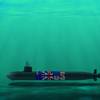With the Navy’s Fleet of the future established, and seeing cost-savings platforms being delivered to the Fleet, the Navy announced Feb. 5 the plan to reach an end strength number of 328,4000 for active duty and 67,800 for reserves in 2008, reaching a floor of approximately 322,000 for active duty and 68,000 for reserves in 2013.
“Now that we have future fleet defined – 313 ships and about 3,800 aircraft – we are able to define the work and identify requirements,” said Chief of Naval Personnel Vice Adm. John C. Harvey Jr. “I’m confident that our end strength number is right, and that the number translates to the capabilities we need to do the missions that the nation expects the Navy to do.”
By partnering with the Navy enterprises, there is a much better understanding of the work requirement across platforms and jobs, at sea and ashore. In addition, savings from BRAC decision 10 years ago, and the delivery of manpower saving platforms to the fleet are making a difference in how many Sailors are needed to do the job. As platforms change – retiring older, manpower and maintenance intensive ships and aircraft - requirements for Sailors are changing.
“Our future carriers will have about 1,000 less Sailors required between the ship and airwing to deliver the same capability of today’s carriers,” Harvey said. “In our 313-ship Navy, you have significant changes in platforms themselves that enable downsizing to continue without giving away capability or making a 24-hour workday for the Sailor.”
Even while end strength comes down over the next year until it steadies in 2013, the Navy’s recruiting missions will grow. With natural attrition and retention figures, as well as the need for an increasingly skilled workforce, a strong recruiting helps to shape a stronger Navy of the future.
“We learned a lesson in the 90’s that we cannot lower recruiting when we’re downsizing, because we must pay attention to how we shape the force of the future,” Harvey added. “We had historic re-enlistment rates after 9/11, but that was a retention rate that couldn’t be sustained over the long haul. This is part of sustaining the force. We want to keep the mid-grade petty officer and the right skill sets who really deliver the goods for us at sea, in terms of the blend of the experience, leadership, capability.”
Seeing the end strength go down until 2013 does not mean that there will be large cuts in today’s enlisted force.
“You are going to have a career with us. We may have rating conversions, but nobody is going to lose a career who has the capability to serve, who wants to serve, and who should serve,” Harvey stated.
Subscribe for
Maritime Reporter E-News
Maritime Reporter E-News is the maritime industry's largest circulation and most authoritative ENews Service, delivered to your Email five times per week










